Which of the following levels of ecological organization is arranged
in the correct sequence from most to least inclusive?
A)
community, ecosystem, individual, population
B) ecosystem,
community, population, individual
C) population, ecosystem,
individual, community
D) individual, population, community,
ecosystem
E) individual, community, population, ecosystem
B
The main reason polar regions are cooler than the equator is that
A) there is more ice at the poles.
B) sunlight strikes the
poles at a lower angle.
C) the poles are farther from the sun.
D) the polar atmosphere is thinner and contains fewer greenhouse
gases.
E) the poles are permanently tilted away from the sun.
B
Which of the following environmental features might influence
microclimates?
A) forest canopy
B) freshly plowed field
C) log on the forest floor
D) large boulder
E) All
of the options are correct.
E
A population is correctly defined as having which of the following characteristics?
I. inhabiting the same general area
II. belonging
to the same species
III. possessing a constant and uniform
density and dispersion
A) I only
B) III only
C) I and II only
D) II and III only
E) I, II, and III
C
An ecologist recorded 12 white-tailed deer, Odocoileus virginianus,
per square mile in one woodlot and 20 per square mile in another
woodlot. What was the ecologist comparing?
A) density
B)
dispersion
C) carrying capacity
D) cohorts
E) range
A
Which of the following groups would be most likely to exhibit uniform
dispersion?
A) red squirrels, who actively defend territories
B) cattails, which grow primarily at edges of lakes and streams
C) dwarf mistletoes, which parasitize particular species of
forest tree
D) moths, in a city at night
E) lake trout,
which seek out cold, deep water high in dissolved oxygen
A
There is strong evidence that two species of cliff-dwelling birds
have nested in the same environment and fed in the same water for
thousands of years, with each having stable population sizes. Based on
this information, which of the following statements is the best
conclusion?
(A) One species is a better diver than the
other species is.
(B) The two birds compete for food
(C)
One species will displace the other
(D) The two birds have
different ecological niches that allow coexistence
(E) One
species eats a more
D
Thrips are insects that feed on rose pollen. Scientists noted that
the thrips population increased in the spring and decreased
dramatically during the summer. The researchers hypothesized that food
abundance was the limiting factor for the population. Which of the
following types of data would be most useful for the scientists to
collect at regular intervals on a designated test plot of rose
plants?
A) Amount of sunlight (hours/day)
B) Mean
temperature (oC)
C) Density of rose pollen produced
(g/m2)
D) Amount of pollen produced by each flower
(g/flower)
C
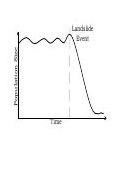
Undersea landslides can disrupt marine habitats by burying organisms
that live on the ocean floor. The graph above shows the size of a
population of a certain organism that lives on the ocean floor. The
population was affected by a recent landslide at the time indicated on
the graph. Which of the following best predicts how the population
will be affected by the landslide?
A) The surviving organisms
will evolve into a new species.
B) The reduced population will
likely have allelic frequencies that are different from the initial
population.
C) The population will adapt to deeper waters to
avoid future landslides.
D) The reduced population will have a
greater number of different genes than the initial population.
B
The observation that members of a population are uniformly
distributed suggests that
(A) The size of the area
occupied by the population is increasing.
(B) Resources are
distributed unevenly
(C) The members of the population are
competing for access to a resource
(D) The members of the
population are neither attracted to nor repelled by one another
(E) The density of the population is low
C
Which of the following is an example of cryptic coloration?
(A) bands on a coral snake (B) brown color of tree bark (C)
markings of a viceroy butterfly (D) colors of an insect-pollinated
flower (E) a "walking stick" insect that resembles a twig
E
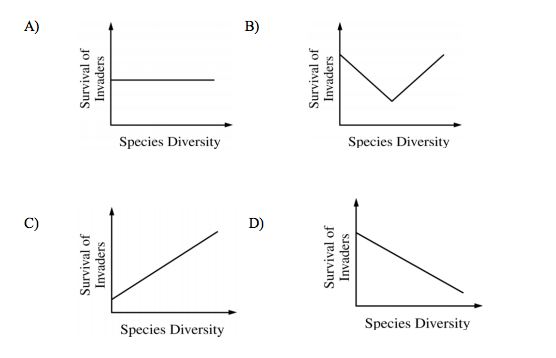
A researcher is investigating the relationship between the existing species diversity in a community and the ability of an introduced nonnative species to destabilize the community. Which of the following graphs is most consistent with the claim that communities with high diversity are more resistant to change than are communities with low diversity?
D
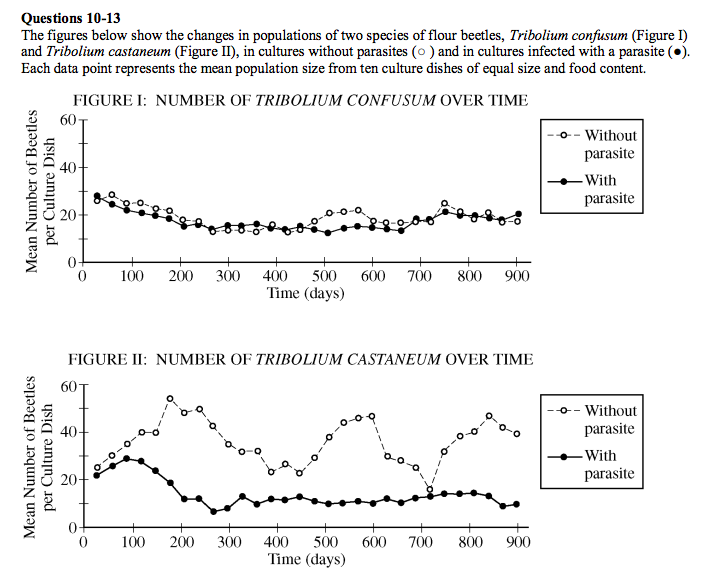
10. Under which of the following conditions is the observed number of beetles per culture dish the greatest?
(A) T. confusum with parasite at 500 days
(B) T. confusum without parasite at 300 days
(C) T. castaneum with parasite at 100 days
(D) T. castaneum with parasite at 600 days
C

11. The data over the duration of the experiment provide the strongest support for which of the following conclusions regarding the effect of the parasite on Tribolium populations? (A) T. confusum is adversely affected by the parasite, while T. castaneum is not.
(B) T. castaneum is adversely affected by the parasite, while T. confusum is not.
(C) Both T. confusum and T. castaneum are adversely affected by the parasite.
(D) Both T. confusum and T. castaneum show increased fitness in the presence of the parasite.
B

12. In Figure I, the difference between the two curves can best be attributed to which of the following?
(A) The difference between controlled laboratory conditions and the natural environment
(B) The effect of the host on its parasite
(C) The influence of competition for limited resources
(D) The natural variation among populations
D

13. If the experiment was continued for an additional 500 days, the population density of T. castaneum with the parasite would most likely stabilize at a value closest to which of the following? (A) 5 beetles/culture dish (B) 10 beetles/culture dish (C) 20 beetles/culture dish (D) 25 beetles/culture dish
B
14. Beaked whales feed at various depths, but they defecate at the ocean’s surface. Nitrogen-rich whale feces deposited in surface waters supply nutrients for algae that are eaten by surface dwelling fish. Which of the following best predicts what would happen if the whale population decreased?
(A) There would be a reduction in surface nitrogen concentration, which would cause an algal bloom.
(B) The surface fish populations would decline due to reduced populations of algae.
(C) The remaining whales would accumulate mutations at a faster rate.
(D) The remaining whales would be forced to forage in the deepest parts of the ocean.
B
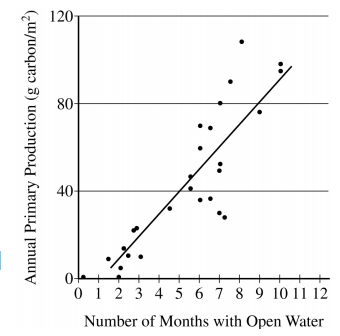
In the Arctic Ocean, the predominant primary producers are phytoplankton. Phytoplankton are consumed by zooplankton, which in turn are eaten by codfish. In years when there is more open water (less ice coverage), there are more zooplankton and fish than in years with less open water (more ice coverage). Based on the graph above, the difference is most likely because (A) when there is less open water, light is blocked from the zooplankton, so they cannot produce as much food for the fish (B) when there is more open water, the temperature is warmer, so the zooplankton and fish populations increase in size
(C) the ice blocks the light, so in years with more ice coverage, there is less photosynthesis by the phytoplankton
(D) the ice increases the light available for photosynthesis, so primary production increases and zooplankton populations increase in size
C
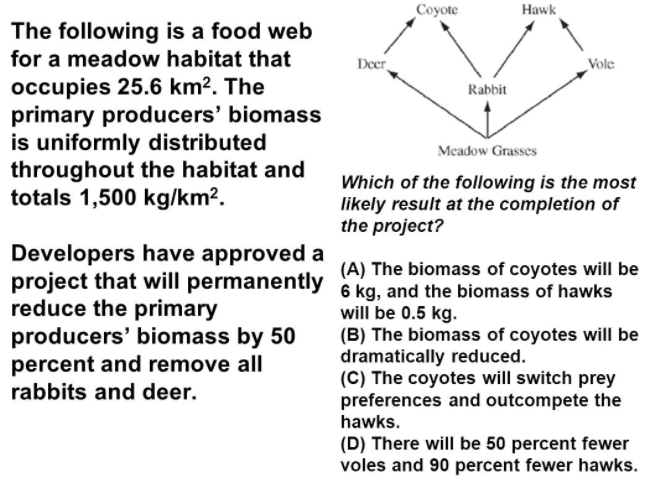
SEE PICTURE
D
Which of the following communities is most likely to be stable?
a. one where a keystone predator has been removed
b. one with uniformly spaced vegetation
c. one with high species diversity
d. one that lacks decomposers
C
Natural selection has led to the evolution of diverse natural history
strategies, which have in common
A)
many offspring per
reproductive episode.
B)
limitation only by
density-independent limiting factors.
C)
adaptation to
stable environments.
D)
maximum lifetime reproductive
success.
E)
relatively large offspring.
D
As N approaches K for a certain population, which of the following is
predicted by the logistic equation?
A)
The growth rate
will not change.
B)
The growth rate will approach zero.
C)
The population will show an Allee effect.
D)
The population will increase exponentially.
E)
The
carrying capacity of the environment will increase.
B
Density-dependent factors are related to which of the following?
A)
cohort
B)
dispersion
C)
Allee
effect
D)
iteroparous
E)
semelparous
C
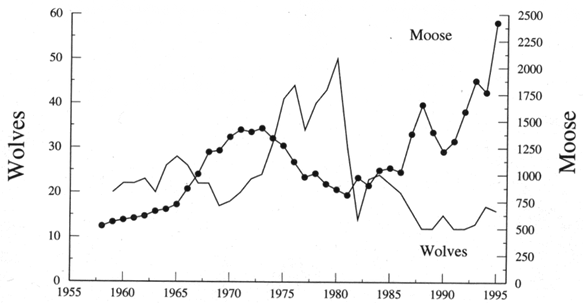
The graph above represents the number of individuals in a population of wolves and in a population of moose observed in the same isolated geographic area over a 40 year period. Which of the following statements about the two populations in supported by the graph?
a. the reproductive rate of the wolves was greater than the reproductive rate of the moose
b mutualism allowed the two populations to reproduce while occupying the same ecological niche
c. speciation occurred when the two populations between reproductively isolated from each other
d. The wolves were predators of the moose, which were otherwise reproductively successful
D
In the year 2000, specimans of C.taxifolia, a green algae used in tropical aquariums was found off the coast of California. It is native to the Indian Ocean. It is known for aggressive reproduction and an ability to compete with sea grasses. It is currently on an international list of invasive species. Which of the following best predicts the consequences of the introduction of C. taxifolia to the California coast?
a. without natural herbivores or competitors, C. taxifolia will grow rapidly and crowd out native species of producers
b. C. taxifolia will have a hard time establishing itself because it will have to compete against native species of sea grasses, which are better adapted to the environment.
c. C. taxifolia will grow rapidly, leading to an increase in the diversity of producers
A
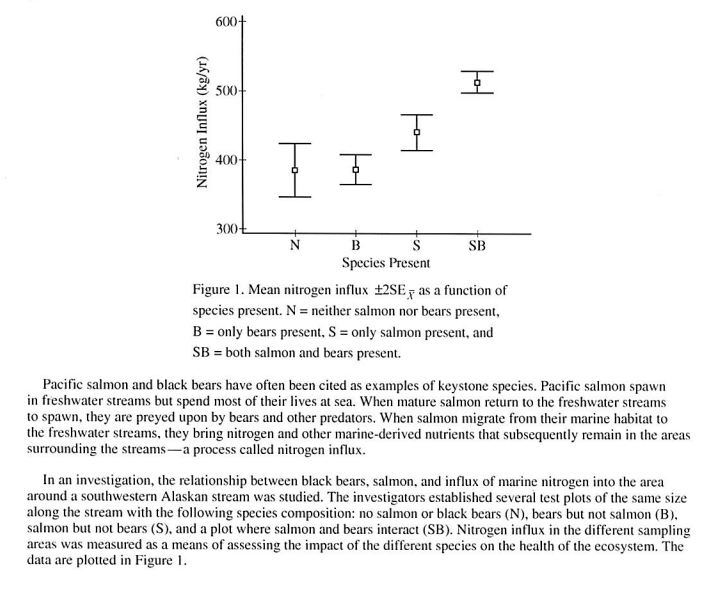
Which of the following statements is best supported by the data?
a. black bears are a keystone species
b. salmon are a keystone species
c. black bear urine is a significant source of nitrogen in the environment
d. the presence of black bears and salmon correlates with a significant increase in nitrogen influx
D

Which of the following most likely describes how the interaction between bears and salmon influences nitrogen dynamics in the environment?
a. when bears consume salmon, they leave parts of the carcasses on the ground, which decompose, releasing nitrogen into the environment
b. when salmon swim upstream to spawn, bears migrate to the rivers, and deposit nitrogen from the forest with their excrement
c. bears are a reservoir for nitrogen because they are the top consumer in the environment
d. bears urinate in rivers and streams which provides nitrogen for the salmon
A

Which of the following pieces of additional data would help further investigate the relationship between bears, salmon, and influx of nitrogen into the local environment?
a. the experimenters should remove the remains of salmon carcasses immediately after the salmon are eaten by the bears and determine the nitrogen content of the carcasses
b. the experimenters should increase the number of bears in the area and measure the amount of nitrogen available for uptake by plants
c. the experimenters should set up a net to catch salmon before they enter the area and then measure nitrogen influx
d. the experimenters should clear cut the trees from the area and determine how much nitrogen remains in the streams
A
If a dam is built downstream and prevents salmon migration to the test sites, which of the following most accurately predicts the impact on nitrogen influx?
a. nitrogen influx will increase because the bears will no longer store nitrogen from the salmon
b. nitrogen influx will decrease because there will be less bear-salmon interaction
c. nitrogen influx will remain stable because organisms other than bears and salmon will mobilize nitrogen in the environment
d. nitrogen influx will increase because bears will longer lose nitrogen to the salmon
B
A scientist is evaluating a proposal for raising large numbers of fish in ocean pens for human consumption. As part of the evaluation, the scientist is designing a plan for investigating how fish in the ocean pens might affect nearby ecosystems. Which of the following is the most appropriate factor to use as the dependent variable in the experimental investigation?
a. the amount of metabolic wastes in the water where the fish are being raised
b. the water temperature in the natural habitat of the fish being studied
c. the types of fish that are preferentially consumed by humans
A
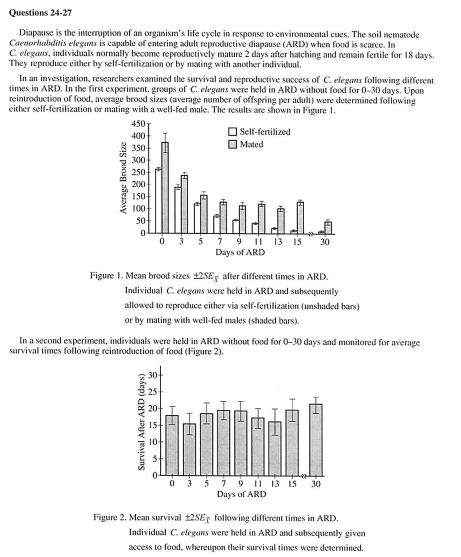
Which of the following best describes the reproductive ability of C. elegans following the ARD induced in the first experiment
a. mating with a well-fed male consistently produced more offspring than did reproduction via self-fertilization
b. the numbers of progeny produced by self-ferilization and by mating with well-fed males were not statistically different
c. C. elegans stopped reproducing after 20 days without food
d. there was no relationship between days without food and average brood size
A

The average brood size per mated individual upon reintroduction of food following 30 days of ARD is closest to which of the following?
a. 10
b. 50
c. 250
d. 400
B

Which of the following conclusions is most consistent with the data shown in Figure 2?
a. animals that spend 3-5 days in ARD are more likely to survive periods of food scarcity than are animals that spend 13-15 days in ARD
b. animals that spend 30 days in ARD live significantly longer after reintroduction of food than animals that spend only 3 days in ARD
c. The number of days an animal spends in ARD does not significantly affect its time of survival after reintroduction of food
d. The large standard errors of the means make conclusions from the data impossible
C
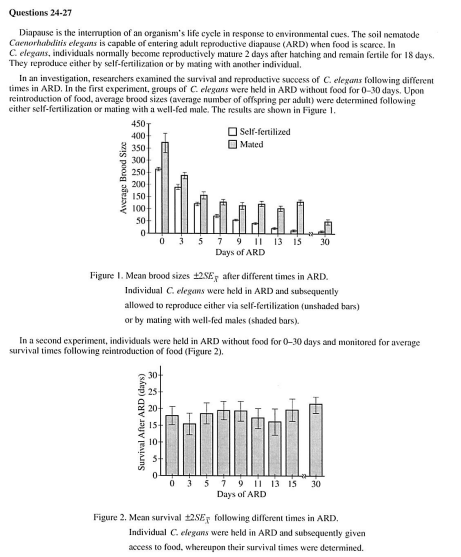
Based on the experimental results, which of the following is the best evolutionary explanation for the occurrence of ARD in C. elegans?
a. The ability to enter ARD provides a strong selective advantage because reproduction can occur despite periods of food scarcity
b. acquiring the genes for ARD gives individuals a selective advantage because they produce more offspring than do individuals who cannot enter ARD
c. Individuals who can enter ARD are selected for in the population because they live longer than do individuals who cannot enter ARD
d. individuals who can enter ARD have high fitness because they can reproduce even when food is scarce
A
During the course of the formation of a parasite/host relationship, a
critical first step in this evolution would be
A) changing the
behavior of the host or intermediate host.
B) developing asexual
reproduction.
C) deriving nourishment without killing the host.
D) starting as an ectoparasite and then later becoming an
endoparasite.
E) utilizing heterotropic nutrition during
infection and autotrophic nutrition during dormancy.
C
The observation that members of a population are uniformly
distributed suggests that
(A) The size of the area
occupied by the population is increasing.
(B) Resources are
distributed unevenly
(C) The members of the population are
competing for access to a resource
(D) The members of the
population are neither attracted to nor repelled by one another
(E) The density of the population is low
C
Which of the following is the most accepted hypothesis as to why
invasive species take over communities into which they have been
introduced?
A) Invasive species are more aggressive than native
species in competing for the limited resources of the environment.
B) Invasive species are not held in check by the predators and
agents of disease that have always been in place for the native
species.
C) Humans carefully select which species will
outcompete nuisance native species.
D) Invasive species have a
higher reproductive potential than native species.
E) Invasive
species come from geographically isolated regions, so when they are
introduced to regions where there is more competition, they thrive.
B
The lionfish is a venomous fish found primarily in the Red Sea and
the Indian Ocean. In the 1990's, lionfish were accidentally released
into the Atlantic Ocean, where they found abundant resources and
favorable environmental condition. Which of the following scenarios is
most likely to result in the lionfish having a major impact on the
community into which they were introduced?
(A) With no
natural predators, the lionfish population will become very large.
(B) Some native species of invertebrates will develop a resistance
to lionfish venom.
(C) Random mating will allow the lionfish
population to reach Hardy-Weinberg equilibrium.
(D)A virus that
specifically infects lionfish will become more prevalent.
A
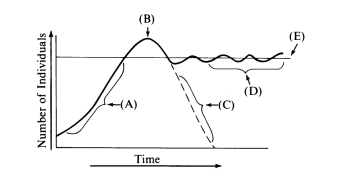
A mature, well-established population in favorable conditions
B

The carrying capacity of the environment
E

A population in unfavorable conditions
C
The exponential growth phase of a new population
A
Two barnacles, Balanus and Chthamalus, can both survive on the lower
rocks just above the low-tide line on the Scottish coast, but only
Balanus actually does so, with Chthamalus adopting a higher zone.
Which of the following best accounts for this niche separation?
A) competitive exclusion
B) predation of Chthamalus by
Balanus
C) cooperative displacement
D) primary succession
E) mutualism
A
Which of the following best describes resource partitioning?
A)
competitive exclusion that results in the success of the superior
species
B) slight variations in niche that allow similar species
to coexist
C) two species that can coevolve to share identical
niches
D) differential resource utilization that results in a
decrease in community species diversity
E) a climax community
that is reached when no new niches are available
B
Which of the following is an example of aposematic
coloration?
A) stripes of a skunk
B) eye color in
humans
C) green color of a plant
D) colors of an
insect-pollinated flower
E) a katydid whose wings look like a
dead leaf
A
Which of the following is an example of Batesian mimicry?
A) an
insect that resembles a twig
B) a butterfly that resembles a
leaf
C) a nonvenomous snake that looks like a venomous
snake
D) a fawn with fur coloring that camouflages it in the
forest environment
E) a snapping turtle that uses its tongue to
mimic a worm, thus attracting fish
C
56) Which of the following can contribute to density-dependent
regulation of populations?
A) the removal of toxic waste by
decomposers
B) intraspecific competition for nutrients
C)
earthquakes
D) floods
E) weather catastrophes
B
Natural selection involves energetic trade-offs between
A)
choosing how many offspring to produce over the course of a lifetime
and how long to live.
B) producing large numbers of gametes when
employing internal fertilization versus fewer numbers of
gametes
when employing external fertilization.
C) the emigration of
individuals when they are no longer reproductively capable or
committing suicide.
D) increasing the number of individuals
produced during each reproductive episode with a
corresponding
decrease in parental care.
E) high survival
rates of offspring and the cost of parental care.
E
25) The three basic variables that make up the life history of an
organism are
A) life expectancy, birth rate, and death
rate.
B) number of reproductive females in the population, age
structure of the population,
and life expectancy.
C) age
when reproduction begins, how often reproduction occurs, and how
many
offspring are produced per reproductive episode.
D) how
often reproduction occurs, life expectancy of females in the
population, and
number of offspring per reproductive
episode.
E) the number of reproductive females in the population,
how often reproduction
occurs, and death rate.
C